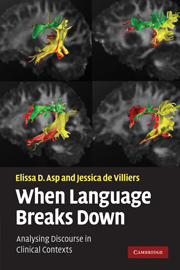Book contents
- Frontmatter
- Contents
- List of figures
- List of tables
- Acknowledgements
- Transcription conventions
- Introduction
- 1 Introduction to clinical discourse analysis
- 2 Theoretical and clinical contexts
- 3 Talk and speech – conversation analysis and intonation in English
- 4 Grammar
- 5 Phase and contexts of culture and situation
- 6 Study design
- 7 Differential diagnosis and monitoring
- 8 Cognitive models, inferencing and affect
- 9 Modelling information across domains
- Closing remarks
- Notes
- Appendix A Some basic grammatical terminology and relations
- Appendix B Inventory of codes
- References
- Author index
- Subject index
Appendix A - Some basic grammatical terminology and relations
Published online by Cambridge University Press: 05 June 2012
- Frontmatter
- Contents
- List of figures
- List of tables
- Acknowledgements
- Transcription conventions
- Introduction
- 1 Introduction to clinical discourse analysis
- 2 Theoretical and clinical contexts
- 3 Talk and speech – conversation analysis and intonation in English
- 4 Grammar
- 5 Phase and contexts of culture and situation
- 6 Study design
- 7 Differential diagnosis and monitoring
- 8 Cognitive models, inferencing and affect
- 9 Modelling information across domains
- Closing remarks
- Notes
- Appendix A Some basic grammatical terminology and relations
- Appendix B Inventory of codes
- References
- Author index
- Subject index
Summary
GRAMMATICAL TERMINOLOGY
CLAUSES AND UTTERANCES
In Chapter 3 we defined the terms Clause and Utterance (pp. 29–32). Here we include brief definitions for convenient reference. The reader is referred to Chapter 3 (pp. 29–32) for broader definitions and examples.
English Clauses can be defined syntactically as consisting of a verb, its arguments and adjuncts as in Cosmo bit Piper yesterday. Independent clauses can also be used alone to ask a question, make a statement or exclamation, or give a command. A simple Clause is also typically spoken as a single tone group.
Meaningful speech phenomena which do not meet the criteria for clause such as incomplete utterances, minimal responses, idiosyncratic vocalizations, and isolated hesitation fillers are labelled as utterances. Utterance refers to any unit which can be assigned a speech function, and/or has a distinct tone group, and/or is a linguistic signal of ideational, interactional, or organizational information about a speaker's message.
MORPHEMES
Morphemes are smallest contrastive units in the grammar. Rabbit, dog, -s, in dogs, -ed in called, -ity in fatality, un- in unhappy, brush in toothbrush are all morphemes. None of these items can be further analysed. For instance, rabbit refers to a small furry long-eared animal that hops, but no part of rabbit is associated with one of these meanings. Morphemes may or may not be words: Whereas rabbit is a word, -s in dogs signifies plural but does not occur as a word.
Words may be simple (e.g. rabbit/dog), compound (toothbrush) or complex (fatality/unhappy).
- Type
- Chapter
- Information
- When Language Breaks DownAnalysing Discourse in Clinical Contexts, pp. 215 - 221Publisher: Cambridge University PressPrint publication year: 2010



